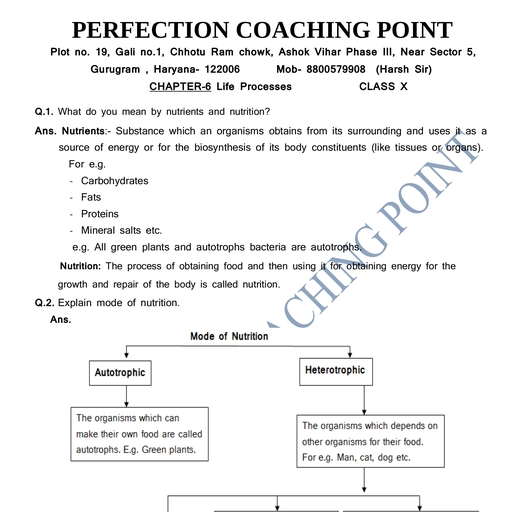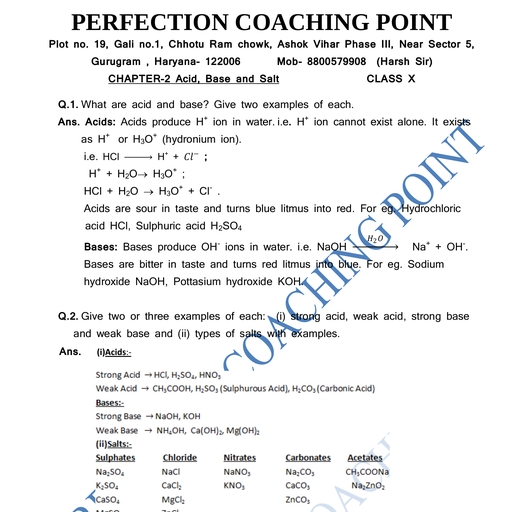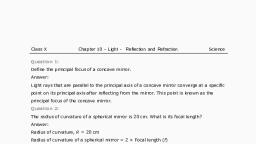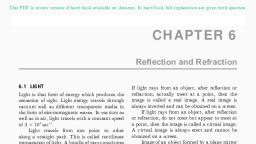Page 1 :
PERFECTION COACHING POINT, Plot no. 19, Gali no.1, Chhotu Ram chowk, Ashok Vihar Phase III, Near Sector 5,, Gurugram , Haryana- 122006, Mob- 8800579908 (Harsh Sir), CHAPTER-10 LIGHT, , CLASS X, , Numerical Problems on Concave mirror, Question 1:- An object is placed at a distance of 10 cm from a concave mirror of focal length 20 cm., (a) Draw a ray diagram for the formation of image., (b) Calculate the image distance., (C) State two characteristics of the image formed., Question 2:- If an object of 10 cm height is placed at a distance of 36 cm from a concave mirror of focal length 12 cm, find, the position, nature and height of the image., Question 3:- At what distance from a concave mirror of focal length 10 cm should an object 2 cm long be placed in order to, get an erect image 6 cm tall?, Question 4:- When an object is placed at a distance of 15 cm from a concave mirror, its image is formed at 10 cm in front of, the mirror. Calculate the focal length of the mirror., Question 5:- An object 3 cm high is placed at a distance of 8 cm from a concave mirror which produces a virtual image 4.5, cm high:, (i) What is the focal length of the mirror?, (ii) What is the position of image?, (iii) Draw a ray-diagram to show the formation of image., Question 6:- A converging mirror forms a real image of height 4 cm of an object of height 1cm placed 20 cm away from the, mirror:, (i) Calculate the image distance. (ii) What is the focal length of the mirror?, Question 7:- An object of size 7.0 cm is placed at 27cm in front of a concave mirror of focal length 18 cm. At what distance, from the mirror should a screen be placed so that a sharp focused image can be obtained? Find the size and, nature of image. [Hint. Find the value of image distance (v) first. The screen should be placed from the, mirror at a distance equal to image distance]., Question 8:- An object 3 cm high is placed at a distance of 10cm in front of a converging mirror of focal length 20 cm. Find, the position, nature and size of the image formed., Question 9:- A concave mirror has a focal length of 4 cm and an object 2 cm tall is placed 9 cm away from it. Find the, nature, position and size of the image formed., Question 10:- When an object is placed 20 cm from a concave mirror, a real image magnified their time is formed. Find:, (a) The focal length of the mirror., (b) Where must the object be placed to give a virtual image three times the height of the object?, Question 11:- A dentist’s mirror has a radius of curvature of 3 cm. How far it must be placed from a small dental cavity to
Page 2 :
give a virtual image of the cavity that is magnified five times?, Question 12:-A large concave mirror has a radius of curvature of 1.5 m. A person stands 10 m in front of the mirror. Where, is the person’s image?, Question 13:- An object of 5.0 cm size is placed at a distance of 20.0 cm from a converging mirror of focal length 15.0 cm., At what distance from the mirror should a screen be placed to get the sharp image? Also calculate the size of, the image., Question 14:- A concave mirror produces three times enlarged virtual image of an object placed at 10 cm in front of it, Calculate the radius of curvature of the mirror., Question 15:- A bright object 50 mm high stands on the axis of a concave mirror of focal length 100 mm and at a distance, of 300 mm from the concave mirror. How big will the image be?, Question 16:- How far should an object be placed from the pole of a converging mirror of focal length 20 cm to from or, 1, real image of the size exactly 4 th the size of the object?, Question 17:- When an object is placed at a distance of 50 cm from a concave spherical mirror, the magnification produced, 1, 1, is - . Where should the object be placed to get a magnification of, - ?, 2, , 5, , Question 18:- An object is placed (a) 20 cm, (b) 4 cm, in front of a concave mirror of focal length 12 cm. Find the nature, and position of the image formed in each case., Question 19:- A concave mirror produces a real image 1 cm tall of an object 2.5 mm tall placed 5 cm from the mirror. Find, the position of the image and the focal length of the mirror., Question 20:- A man holds a spherical shaving mirror of radius of curvature 60 cm, and focal length 30 cm, at a distance of, 15 cm, from his nose. Find the position of image, and calculate the magnification., , Numerical problems on convex mirror, Question 21:- An object is kept at a distance of 5 cm in front of a convex mirror of focal length 10 cm. Calculate the position, and magnification of the image and state its nature., Question 22:- An object is placed at a distance of 10 cm from a convex mirror of focal length 5 cm., a) Draw a ray diagram showing the formation of image., b) State two characteristics of the image formed., c) Calculate the distance of the image from mirror., Question 23:- An object is placed at a distance of 6 m from a convex mirror of focal length 12 cm. Find the position and, nature of the image., Question 24:- An arrow 2.5 cm high is placed at a distance of 25 cm from a diverging mirror of focal length 20cm. Find the, nature, position and size of the image formed., Question 25:- A convex mirror used as a rear view mirror in a car has a radius of curvature of 3m. If a bus is located at a, distance of 5 meter from this mirror, find the position of image. What is the nature of the image?, Question 26:- The radius of curvature of a convex mirror used as a rear view mirror in a moving car is 2.0m. A truck is, coming from behind it at a distance of 3.5 meter. Calculate (a) position and (b)size of the image relative to, the size of the truck. What will be the nature of the image?, Question 27:- A shop security mirror 5.0 from certain items displayed in the shop produces one-tenth magnification. (a)
Page 3 :
What is the type of mirror? (b) What is the radius of curvature of the mirror?, Question 28:- An object 20 cm from a spherical mirror gives rise to a virtual image 15 cm behind the mirror. Determine the, magnification of the image and the type of mirror used., , Refractive Index, Question 29:- A beam of light passes from air into a substance X. If the angle of incidence be 72 degree and the angle of, refraction be 40 degree, calculate the refractive index of the substance X. (Given: sin 72 degree =0.951 and, sin 40 degree = 0.642), Question 30:- Light enters from air into a glass plate having refractive index 1.50. What is the speed of light in glass? (The, speed of light in vacuum is 3 into 10 ki power 8 meter per second.), Question 31:- If the refractive index of water for light going from air to water be 1.33, what will be the refractive index for, light going from water to air?, Question 32:- The refractive indices of kerosene, turpentine and water are 1.44, 1.47 and 1.33 respectively. In which of, these materials does light travel fastest?, Question 33:-What is the speed of light in a medium of refractive index 6/5 if its speed in air is 3, 00,000 km/s?, Question 34:- Light enters from air into diamond which has a refractive index of 2.42. Calculate the speed of light in, diamond. The speed of light in air is 3.0 multiply 10 raise to the power 8 meter per second., , Numerical on Convex lens, Question 35:- A convex lens of focal length 10 centimeter is placed at a distance of 12cm from a wall. How far from the lens, should an object be placed so as to form its real image on the wall?, Question 36:- An object 4 cm high is placed at a distance of 10 cm from a convex lens of focal length 20cm. Find the, position nature and size of the image., Question 37:- A small object is so place in front of a convex lens of focal length that a virtual image is formed at a distance, of 25cm.Find the magnification., Question 38:- Find the position and nature of the image of an object 5 cm high and 10 cm in front of a convex lens of focal, length 6 cm., Question 39:- A convex lens produces an inverted image magnified three times of an object placed at a distance of 15cm, from it. Calculate focal length of the lens., Question 40:- A converging lens of focal length 5cm is placed at a distance of 20 cm from a screen. How far from the lens, should an object be placed so as to form its real image on the screen?, Question 41:- The filament of a lamp is 80 cm from a screen and a converging lens forms an image of it on a screen,, magnified three times. Find the distance of the lens from the filament and the focal length of the lens., Question 42:- A lens of focal length 20cm is used to produce a ten times magnified image of a film slide on a screen. How, far must the slide be placed from the lens?, , Numerical Problems on Concave Lens, Question 43:- An object is placed at a distance of 4 cm from a concave lens of focal length 12 cm. Find the position and, nature of the image., Question 44:- A concave lens of focal length 15cm forms an image 10cm from the lens. How far is the object placed from, the lens? Draw the ray diagram., Question 45:- Calculate the image distance for an object of height 12 mm at a distance of 0.20m from a concave lens of, focal length 0.30m, and state the nature and size of the image.
Page 4 :
Question 46:- A 2.0 cm tall object is placed 40 cm from a diverging lens of focal length 15 cm. Find the position and size of, the image., Question 47:- An object is placed 20cm from (a) a converging lens and (b) a diverging lens of focal length 15 cm. Calculate, the image position and magnification in each case., Question 48:- An object is 2 m from a lens which forms an erect image one fourth (exactly) the size of the object., Determine the focal length of the lens. What type of lens is this?, Question 49:-An image formed on a screen is three times the size of the object. The object and screen are 80 cm apart, when the image is sharply focused.(a) State which type of lens is used. (b) Calculate focal length of the lens., , Power of the lens, Question 50:- A convex lens is a focal length 10 cm. What is its power?, Question 51:- A person having a myopic eye uses a concave lens of focal length 50 cm. What is the power of the lens?, Question 52:- A convex lens forms a real and inverted image of a needle at a distance of 50 cm from the lens. If the image is, of the same size as the needle, where is the needle placed in front of the lens? Also, find the power of the lens., Question 53:- Two thin lenses of power + 3.5D and -2.5D are placed in contact. Find the power and focal length of the lens, combination., , ANSWERS, [Ans1:- (b) 20cm (c) virtual and erect; Magnified], [Ans2:- v = -18cm; Real and inverted; 5 cm], [Ans3:- u = -6.66cm; The object should be placed at a distance of 6.66 cm on the left side of concave mirror], [Ans4:- 6 cm], [Ans5 :-(i) 24 cm (ii) 12 cm behind the concave mirror (on its right side)], [Ans6:-(i)80 cm in front of the mirror (ii)16 cm], [Ans7:-v=-54 cm; The screen should be placed at a distance of 54 cm in, front of the concave mirror; 14.0; Real and inverted], [Ans8:-v=+20 cm; The image is formed at a distance of 20 cm, behind the converging mirror; Virtual and erect; 6cm], [Ans9:-Real and inverted; v=-7.2 cm: The image is formed at a, distance of 7.2 cm in front of concave mirror; 1.6 cm], [Ans10 :-(a) 15 cm (b)10 cm from the concave mirror; ], [Ans11:-1.2 cm], [Ans12:-0.81 m in front of the concave mirror] [Ans13:-60 cm in front of the converging mirror; 15.0, cm], [Ans14:-30 cm], [Ans15:-25 mm], [Ans16:-100 cm] [Ans17:-100 cm], [Ans18 :-( a) v=-30 cm; The image is formed at a distance of 30 cm in front of mirror (on its left side); Real and inverted (b), v=+6 cm; The image is formed at a distance of 6 behind the mirror (on its right side); Virtual and erect], [Ans19:-u=-20 cm; The image is formed 20 cm in front of the mirror; 4 cm], [Ans20:-v=+30 cm; The image is formed at a distance of 30 cm behind the mirror; m=+2], (Ans21: 3.3cm behind the convex mirror; Virtual and erect) (Ans22: Virtual and erect; Smaller than the object or, diminished; 3.3cm behind the convex mirror), (Ans23:4cm behind the mirror; Virtual and erect), (Ans24: v=11.1 cm; The image is formed 11.1cm behind the convex mirror; Virtual and erect; 1.1cm tall), (Ans25:1.15m behind the mirror; Virtual and erect.) (Ans26 :( a) 0.77m behind the mirror; (b)1/4.5; Virtual and erect), (Ans27: (a) Convex mirror (b) 10/9m), (Ans28: m= +0.75; Convex mirror) (Ans29: 1.48), (Ans30: 2×108 m/s), (Ans31: 0.75), (Ans32: water has the lowest refractive index of 1.33. So, the light will have maximum speed in water or, light will travel fastest in water.) (Ans33:2, 50,000km/s), (Ans34: 1.42× 108 m/s) (Ans35: u=-60cm), (Ans36:v= -20cm; Virtual and erect) (Ans37: +6) (Ans38: v=+15cm; Real and Inverted), (Ans39: 11.2cm), (Ans40: 6.6cm) (Ans41: 20cm; +15cm), (Ans42: 220cm behind the lens), (Ans43: v=-3cm; Virtual and erect), (Ans 44: u= -30cm) (Ans45: V=-0.12m; virtual and erect; 7.2mm tall) (Ans46: v=-10.90cm; 0.54cm tall), (Ans47 :( a)+60cm; m=-3 (b) v=-8.5cm; m=+0.42) (Ans48: f=-66.7cm; concave lens) (Ans49: (a) Convex lens (a) +15cm), (Ans50: +10D) (Ans51: -2D) (Ans52: 50cm from lens in front; +4D) (Ans53: +1.0D; f= +1m)





















































































